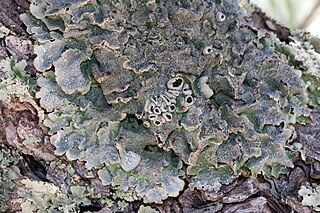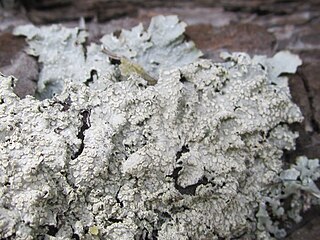
Punctelia is a genus of foliose lichens belonging to the large family Parmeliaceae. The genus, which contains about 50 species, was segregated from genus Parmelia in 1982. Characteristics that define Punctelia include the presence of hook-like to thread-like conidia, simple rhizines, and point-like pseudocyphellae. It is this last feature that is alluded to in the vernacular names speckled shield lichens or speckleback lichens.

Punctelia rudecta, commonly known as the rough speckled shield or the speckleback lichen, is a North American species of foliose lichen in the family Parmeliaceae. This species can be readily identified by the light color of the thallus underside, the relatively large lobes at the edges of the thallus, and the tiny white pores present on the top of the thallus that are characteristic of the genus Punctelia. The lichen is quite abundant and widespread in the eastern and southeastern United States, although it also occurs in Canada and northern Mexico, but is less common in these regions. The lichen usually grows on bark, and less commonly on shaded rocks. There are several lookalike Punctelia species; these can often be distinguished from P. rudecta by differences in distribution or in the nature of the reproductive structures present on the thallus.
Punctelia constantimontium is a species of foliose lichen in the family Parmeliaceae. Its range includes South America, Africa, and Mexico, where it grows on bark and twigs.

Punctelia appalachensis, commonly known as the Appalachian speckled shield lichen, is a species of foliose lichen in the family Parmeliaceae. It is found in the eastern United States and eastern Canada. The lichen was first formally described in 1962 by lichenologist William Culberson as a species of Parmelia. He collected the type specimen growing on tree bark in West Virginia, Hildur Krog transferred it to the newly circumscribed genus Punctelia in 1982.

Punctelia reddenda is a widely distributed species of foliose lichen in the family Parmeliaceae. It occurs in Africa, Europe, North America, and South America, where it grows on bark and on rock.
Punctelia negata is a little-known species of foliose lichen in the family Parmeliaceae. It is found in South America.
Punctelia riograndensis is a species of foliose lichen in the family Parmeliaceae. Found in Africa and South America, it was formally described as a new species by Norwegian lichenologist Bernt Lynge in 1914, as Parmelia riograndensis. The type specimen was collected in 1892 from Porto Alegre Municipality in Rio Grande do Sul State (Brazil) by Swedish lichenologist Gustav Malme. In 1982, Hildur Krog circumscribed the genus Punctelia to contain Parmelia species with rounded pseudocyphellae, and P. riograndensis was one of the 22 species that she transferred to the new genus.
Punctelia jujensis is a species of foliose lichen in the family Parmeliaceae. It is found in Argentina and Brazil.
Punctelia colombiana is a species of corticolous (bark-dwelling) and foliose (leafy) lichen in the family Parmeliaceae. It is found in South America.
Punctelia subpraesignis is a species of foliose lichen in the family Parmeliaceae. It occurs in Mexico, South America, and East Africa, where it grows on bark and on rocks. Major characteristics of the lichen that distinguish it from other Punctelia species include the C+ and KC+ rose spot tests of the medulla, ascospores that are smaller than 20 μm, and unciform (hooklike) conidia.

Punctelia punctilla is a species of foliose lichen in the family Parmeliaceae. It is found in Africa, South America, and North America, where it grows on bark and on rocks. The main characteristics that distinguish Punctelia punctilla from other species of Punctelia are the presence of isidia on the thallus surface, a pale brown thallus undersurface, and the presence of lecanoric acid in the medulla.

Punctelia hypoleucites, commonly known as the southwestern speckled shield lichen, is a species of foliose (leafy) lichen in the family Parmeliaceae. First formally described by Finnish botanist William Nylander as a species of Parmelia, it was transferred to the genus Punctelia in 1982. The lichen is found in Africa, North America, and South America, where it grows on the bark of both hardwood and coniferous trees. Its greenish-grey thallus is covered with tiny white pseudocyphellae – minute holes in the thallus surface that facilitate gas exchange. Some macroscopic features that help distinguish this species from other related members of the genus include the presence and the structure of the apothecia, the absence of asexual surface propagules, and the light brown color of the thallus undersurface. Chemically, the presence of lecanoric acid in the medulla and atranorin in the cortex help distinguish it from lookalikes.
Flavopunctelia praesignis is a species of foliose lichen in the family Parmeliaceae. It was first described as Parmelia praesignis by Finnish botanist William Nylander in 1872. In 1982, Hildur Krog transferred it to the subgenus Flavopunctelia of her newly circumscribed genus Punctelia, created to contain Parmelia species with punctate (point-like) pseudocyphellae. Mason Hale raised this subgenus to generic status a couple of years later. The lichen is colloquially known as the fruiting speckled greenshield. It is found in the southern United States, in various states of Mexico, and in South America. It has also been reported from Kenya, but that may be due to misidentification.
Punctelia pseudocoralloidea is a species of foliose lichen in the family Parmeliaceae. It is found in Australia, where it grows on bark and on wood.

Punctelia bolliana, the eastern speckled shield lichen, is a species of foliose lichen in the family Parmeliaceae. It is found in North America, with a distribution extending from the Canadian province of Ontario south to the central and northeastern United States and Mexico. It grows on the bark of both deciduous trees and coniferous trees. The combination of characteristics that distinguishes this species from others in genus Punctelia are the absence of the vegetative propagules isidia and soralia, a pale brown lower thallus surface, and the presence of the secondary chemical protolichesterinic acid in the medulla.
Punctelia borrerina is a species of foliose lichen in the family Parmeliaceae. It is found in Mexico and South America.

Punctelia perreticulata is a widely distributed species of foliose lichen in the family Parmeliaceae. It occurs in Mediterranean Europe and Russia, North America, South America, Australia, and New Zealand, where it grows on rocks, bark, or wood. Its main distinguishing features are its thallus surface, marked with many shallow depressions, grooves, or pits, and sorediate pseudocyphellae. The lower side of the thallus is ivory to tan towards the centre and the major secondary metabolite in the medulla is lecanoric acid. A lookalike species with which it has been historically confused is Punctelia subrudecta; this lichen can be distinguished from Punctelia perreticulata by the texture of the thallus surface, or, more reliably, by the length of its conidia.

Punctelia graminicola is a species of foliose (leafy) lichen in the family Parmeliaceae. It grows on rocks, and, less frequently, on bark in North America, South America, and East Africa. It has a blue-grey thallus measuring up to about 15 cm (6 in), covered with tiny pores called pseudocyphellae. Sometimes the lichen forms small lobes that project out from the surface. Fruiting bodies are uncommon in this species; if present, they resemble small cups with a brown internal disc measuring 3–10 mm (0.1–0.4 in) in diameter. A lookalike species, Punctelia hypoleucites, is not readily distinguishable from Punctelia graminicola by appearance or habitat alone; these species can only be reliably differentiated by examining the length of their conidia.
Punctelia microsticta is a species of foliose lichen in the family Parmeliaceae. It occurs in Brazil and Argentina, where it grows on bark.

Punctelia borreri is a species of foliose lichen in the family Parmeliaceae. It is a common and widely distributed species, occurring in tropical, subtropical, and temperate regions of Africa, Asia, Europe, North America, Oceania, and South America. The lichen typically grows on bark of deciduous trees, and less commonly on rock. Some European countries have reported increases in the geographic range or regional frequency of the lichen in recent decades, attributed alternatively to a reduction of atmospheric sulphur dioxide levels or an increase in temperatures resulting from climate change.









